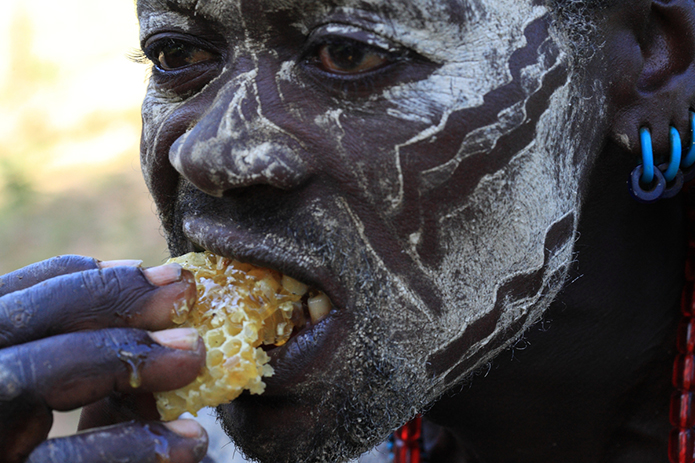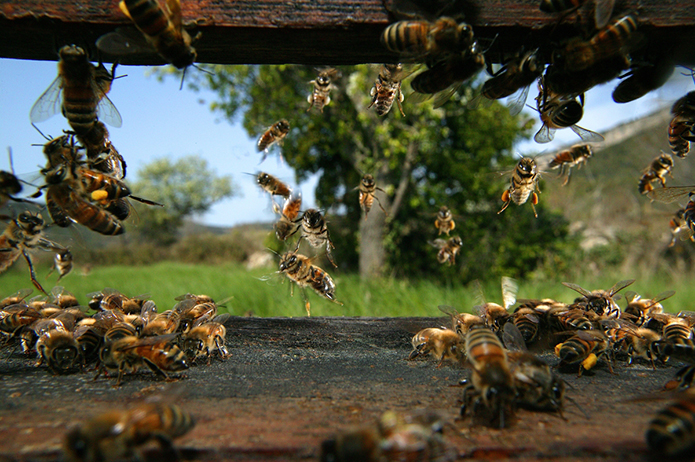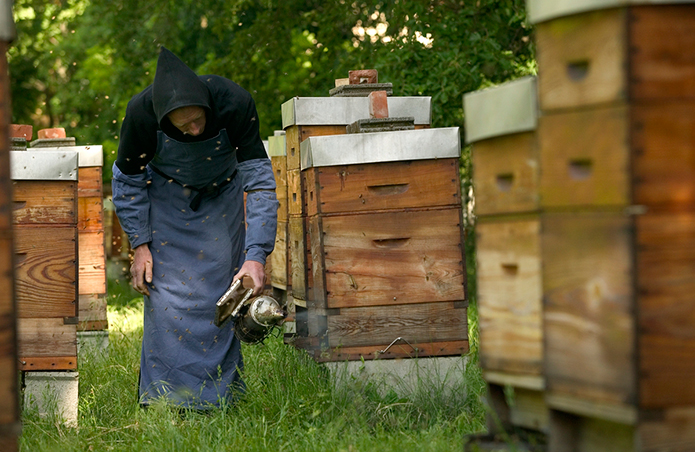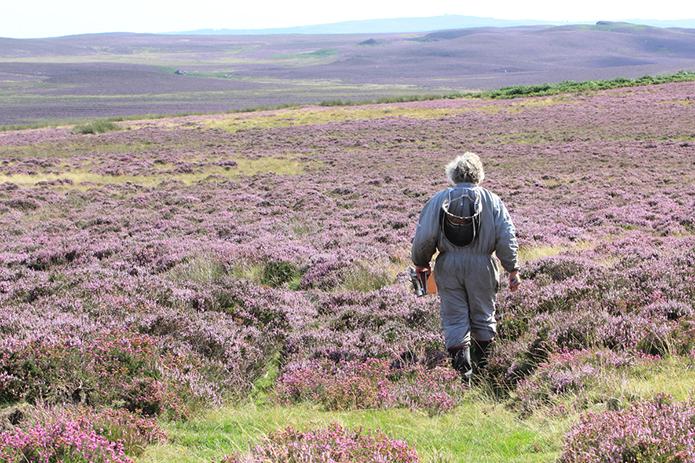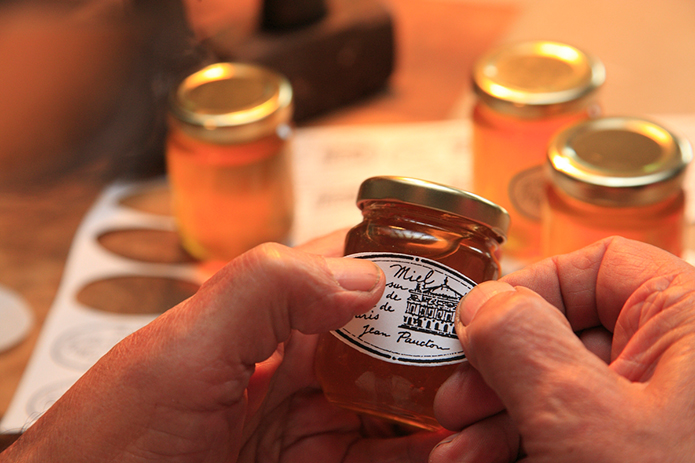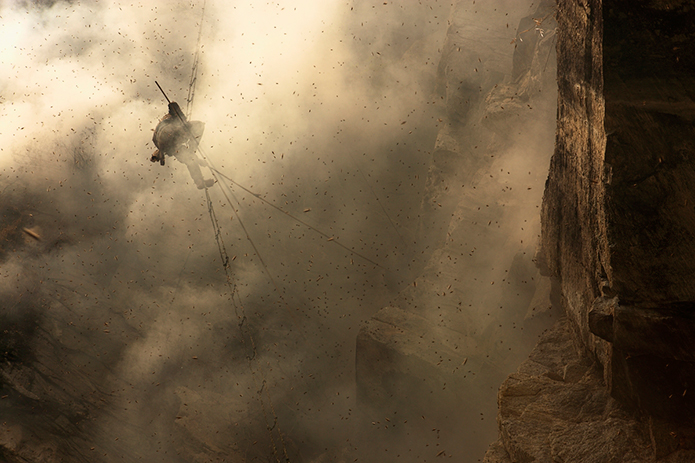
Image © Éric Tourneret / www.thehoneygatherers.com.
All over the planet the humble honey bee busies itself with a singular purpose – perpetuation of the hive. Highly organised work-forces operate together with seamless efficiency collecting pollen and nectar for their micro-industry, creating the magical elixir honey, which will sustain the colony, most importantly feeding the omnipotent queen and her offspring, throughout the year, especially in the cold dark months of the flowerless winter. At the same time, again all over the planet, many human beings are also on a mission to hunt for bees, harness or host their hives and gather the honey for their own uses; be that culinary, medicinal or cosmetic.
The honey hunter-gatherer’s quest varies from harvesting honey from naturally occurring to purpose built hives, in all sorts of environments; from cliffs to deltas, gardens to abbeys, large-scale bee-‘farms’ to singular hives dotted over a cityscape. …And, all over the planet, one man, Eric Tourneret, has travelled, dedicating his career as a successful, well-published photojournalist of 25 years (his work has been showcased in Figaro, Paris Match, Terre Sauvage etc) to discovering and displaying the types and traditions of beekeeping, honey hunting and honey gathering; his quest enhanced by developments in digital photography to create the most exquisite images of bees and their keepers – their hunter-gatherers in different societies and subcultures, some of which are increasingly threatened by the creep and crush of globalisation.
His resultant body of work, the publications Le Peuple des Abeilles (The People of the Bees, Rustica, 2007) and Cueilleurs de Miel (The Honey Gatherers, Rustica, 2009) have become an important reference to the bee and beekeeping. Eric’s fascinating findings have become all the more important as mankind’s global relationship with this tiny, humble, yet extra-ordinary creature, is on the cusp of drastic times.
Man’s excessive use of artificial and damaging chemicals, such as fertilisers, herbicides and pesticides, has become intrinsic within modern-day intensive farming methods, due especially to our obsession with monoculture, in our constant quest for (over)production. This, coupled with increasing disease within the bee population, all continues to weaken the bee, and their colonies and man-managed hives throughout the world. The effect of a significantly reduced bee population has stark consequences to mankind, relying, as we do, on these tiny creatures to pollinate and perpetuate our crops, and therefore sustain our system of food production.
Like a worker bee dancing outside the hive to explain to her counterparts where the best pollen can be found, we can showcase Eric’s thought-provoking journey, as it ‘dances’ around the world, twisting and turning, explaining to us, in stunning visuals, where the bee thrives, who are the hunter-gatherers, how the relationship between bee and man is sustained, and what challenges face bee and man in the future.
Let us follow Eric’s steps around the world, and hear his commentary (in italics); we hope you enjoy and inspired by the twists and turns…
Honey Tribes of Omo Valley, Ethiopia
One of the last virgin spaces in Africa, the abundant Omo Valley in southernmost Ethiopia, has been thought to have been a crossroads for thousands of years as various cultures and ethnic groups were attracted to its natural bounty, and now it is on the cusp of monumental change; bridges, dams and roads are opening up the traditional valley to the world, increased transportation, tourism, and soon intensive sugar cane production. This development will have a profound effect upon the semi-nomadic Bana tribe, who farm cattle and goats and build bee hives in the trees. Bees, their honey and mead-making are age-old traditions for these people. How will the transformation of their valley affect their centuries-old way of life?
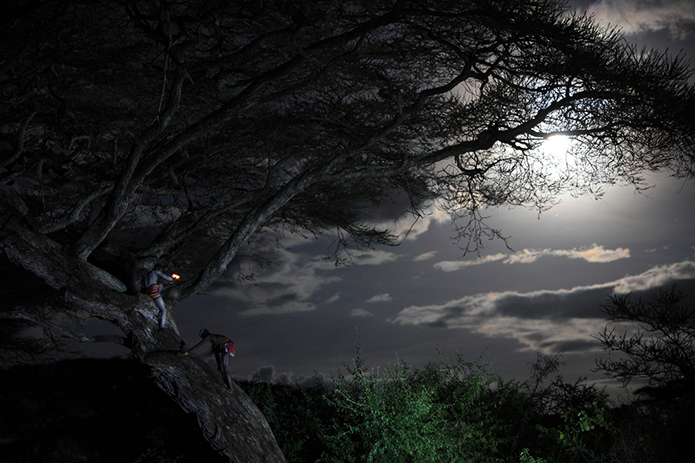
In the land of the Bana tribe, the harvest of the hive trees takes place at nightfall in the moonlight. Image © Éric Tourneret / www.thehoneygatherers.com.
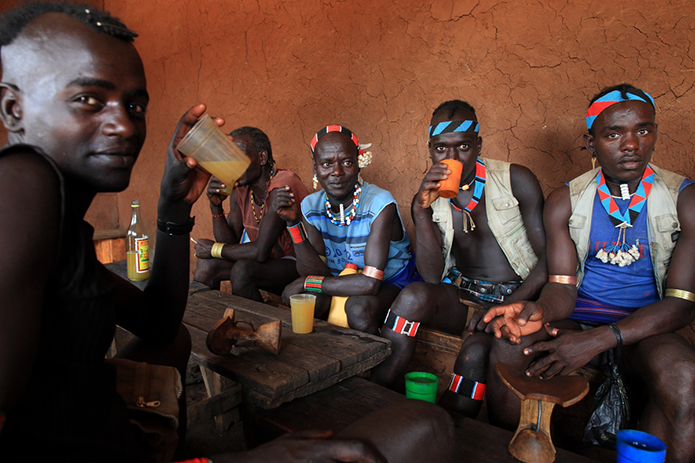
On market days in the Bana village of Kako, the mead bars do great businesses with the Bana men who come to drink litres of teji, which, though not very alcoholic, inebriate quickly. Image © Éric Tourneret / www.thehoneygatherers.com.
Argentina’s Boatmen Beekeepers
From the beginnings of time, and from thousands of miles north of Buenos Aires, high on the Brazilian plateaus, the ochre waters of the Paraná River blends with the azure waters of the Uruguay River in the south. This union forms the vast Rio de la Plata, opening out gigantically into the Atlantic as a huge estuary, and at the mouth is the Paraná Delta; at 340 km long and 60 km wide, it is one of the largest on the planet, a natural puzzle of rivers, lagoons and marshy isles, some floating (purely a mass of tangled vegetation weighed down by mud and sediment), others fixed.
This maze of marshland islands is increasingly encroached upon by livestock farmers, pushed south by the expansion of industrial GM soy farming from the north. This in turn pushes the beekeeper boatmen of the delta, traditional transhumance farmers, further onto the delta and away from the mountains in the north, traditionally used for part of their farming year, in order to find bees feeding on the white Catay flower, and harvest the honey from them. How long until they are pushed so far out onto the delta that their way of life becomes unsustainable?
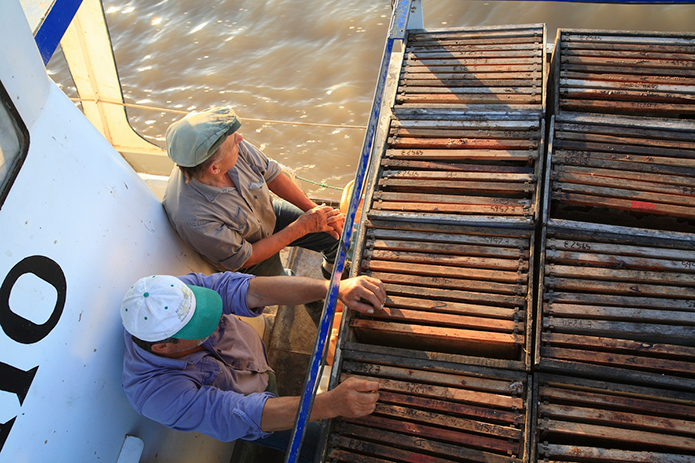
The modern hives used in Argentina are made up of two parts: the body, where the queen lays her eggs, is the bees’ habitat, where they raise the brood and stock the honey and pollen that feeds the larvae; and the supers, to which the queen does not have access, which is reserved for the production of the honey. When the super is full, the beekeeper takes it out to harvest the honey and replaces it with another empty one. Image © Éric Tourneret / www.thehoneygatherers.com.
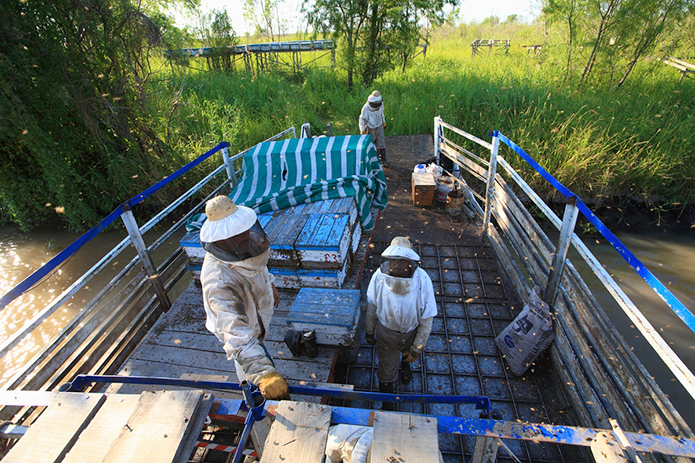
Under general attack by the swarms, the unloading and setting up of the hives has to be done very quickly. En masse, the bees have left the hives, left open because of the heat. Image © Éric Tourneret / www.thehoneygatherers.com.
Fairtrade in Mexico – sting-less bees next door
Stingless bees (trigona scaptotrigona) are native to equatorial zones of Australia, Africa and the Americas, building their hives in hollow tree trunks. However, they can also be found in earthenware pots, as well as trunks, by the walls of houses occupied by the coffee-making Nahuat and Totonac families in Puebla on the foothills of the Sierra Madre, Mexico. This community is The Tosepan Titataniske (United, We Conquer) cooperative, made up of nearly 6,000 families regrouped to market Fairtrade coffee. As well as the coffee cultivation, the bees are managed, literally next-door to the houses – convenient ‘home-working’ – continuing the tradition which historically was undertaken by the women in the pre-Hispanic era. This idyllic set-up, however, is under threat, as the stingless bees are being affected by the pesticides used within the surrounding mono-cultural farmlands and the stronger African bees.
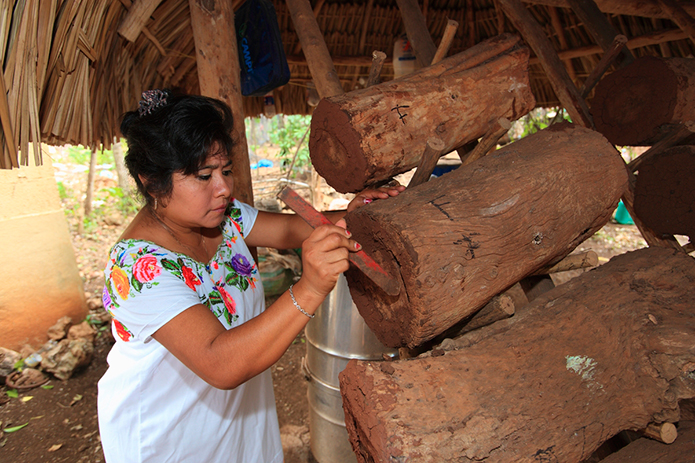
The opening to a melipona beecheii’s trunk hive sealed at each end with dried earth. When Hernan Cortés landed with his armada in 1519, he discovered apiaries made up of several hundreds of hollowed out trunks placed horizontally in the shelter of palms. Image © Éric Tourneret / www.thehoneygatherers.com.
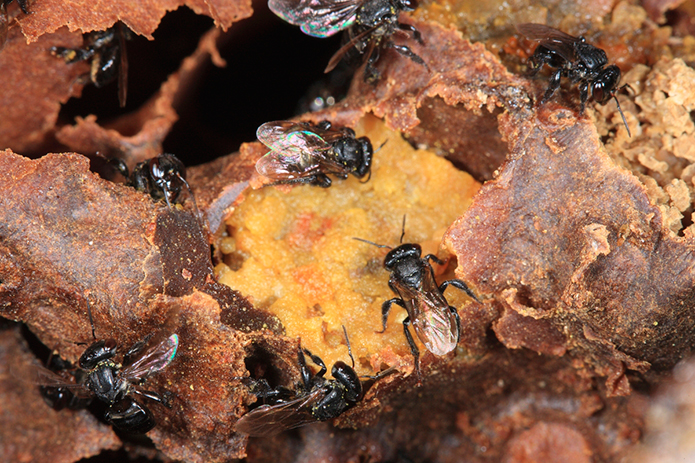
Unlike the European apis mellifera, the trigona scaptotrigona bee does not store the stock of honey and pollen in hexagonal cells, but in pockets sitting outside the brood cells. Image © Éric Tourneret / www.thehoneygatherers.com.
Nepal’s ‘Supernatural’ Tiger Men Hunt For Honey
The Kirates arrived in Nepal from Mongolia in 800BC and Yalembar, the first sovereign of Nepal (cited in the epic Sanskrit tome Mahabharata), was a Kirate. Descendants of the Kirates, and there have been 33 sovereign successors, are the Raï people, settling in the foothills of the Himalayas, 20km to the south of Mt Everest (but still at an altitude of over 2,000 metres).
There are mythical tales of legendary Kirates, known locally as ‘tiger men’, as superhumanly battling with the aggressive giant bee of the Himalayas (as super-sized as the environment it inhabits) to gather their honey the bees have made from feeding on rhododendron flowers growing between 6,000-19,000 feet up, during April, May and June. Raï menfolk are still continuing their ancestral acrobatics, scaling cliffs over 300 feet high on bamboo ladders, without shoes and gloves, let alone the protective suits we are used to seeing, smoking, poking and thus provoking the hives, to release the angry swarm of giant stinging-machines in order to harvest the honey. Superhuman? Yes.
Bolo Kesher Raï is the “Perengge”, the man who gathers the honey. “My father was a Perengge, and my grandfather before him. I gathered honey for the first time at the age of 16 or 17, with my grandfather. There were twelve nests on the cliff face, my grandfather was old and he fell at the fifth one. So, I in turn climbed up and harvested the seven nests remaining. Of course, another man could have done it, but it is our family’s role to gather honey.”
Away from the ladder itself, Perengge’s son, Shimbu, is at a carefully chosen observation post from which he will be able to shout instructions to the helpers at the top of the cliff; they have to move the harvest basket ‘blind’ as they cannot see it from way down the cliff. Just before the start of this hair-raisingly dangerous quest, Bolo Kesher pours the chang (millet beer) onto the cliff’s rocks as an offering, then sharing a glassful between all the workers. This ritual sharing is an attempt to appease the cliff’s spirit.
Then the fire is lit, which sets off a massive attack by the swarms whilst Bolo Kesher chants an ancient prayer, which has been passed down through the generations, to invoke the guardian spirit of the cliff. Then he attaches a rope to the ladder and begins handling the long bamboo poles, whilst being attacked by the swarms. Others, called rebokipe (rebo means rope ladder in Raï), keep the ladder pulled tight, by hanging their full weight from the ladder, to help Bolo Kesher’s progress, and move the ladder across the cliff face between nests.
Bolo Kesher continues to gather the honey, by hanging like an circus acrobat – albeit one blinded by smoke and stung by giant bees – hundreds of feet above the rock below, without any safety equipment; this requires enormous physical strength, total self-belief and super-human composure, as some of these cliffs are names in memory of those who have fallen to their deaths.
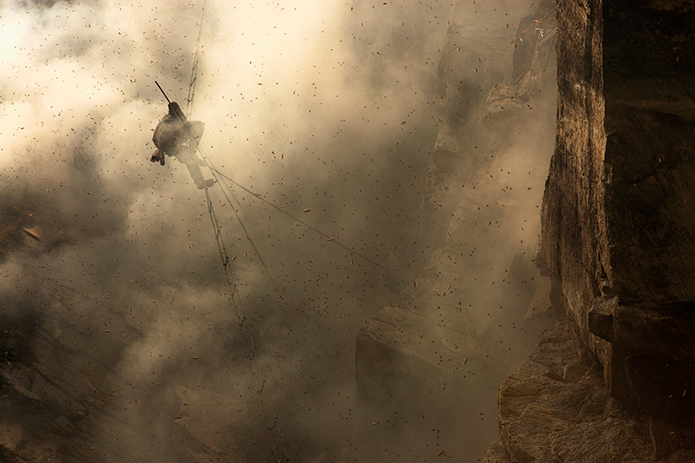
Here, time stands still. This same phantasmagoric harvest spectacle was taking place 30,000 years ago, when the first honey hunters faced the savage swarms. Image © Éric Tourneret / www.thehoneygatherers.com.
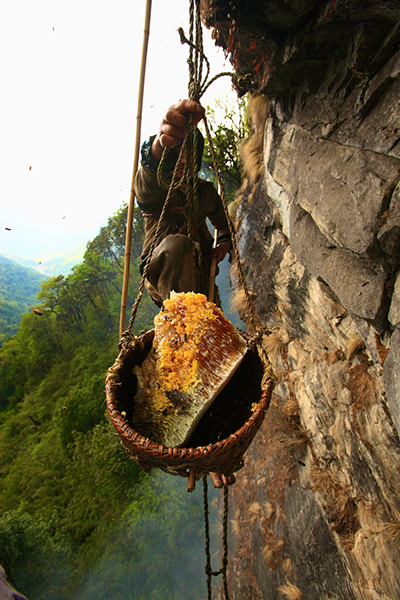
From the top of the cliff, two men adjust the tension of the rope supporting the basket to collect the honeycomb. Image © Éric Tourneret / www.thehoneygatherers.com.
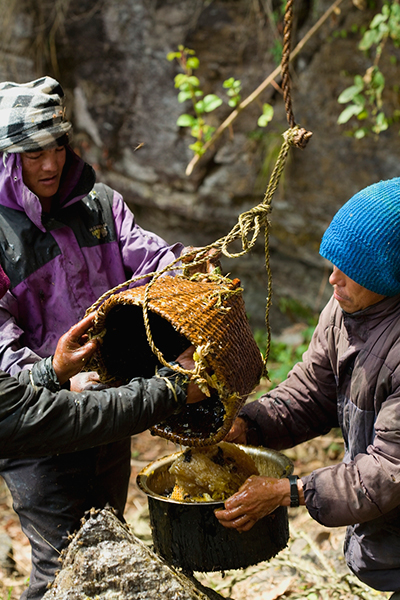
The men responsible for recovering honey are the khudhapup (“khuda” means honey in Rai). They empty the basket into a large, repoussé metal jar before filtering it. Image © Éric Tourneret / www.thehoneygatherers.com.
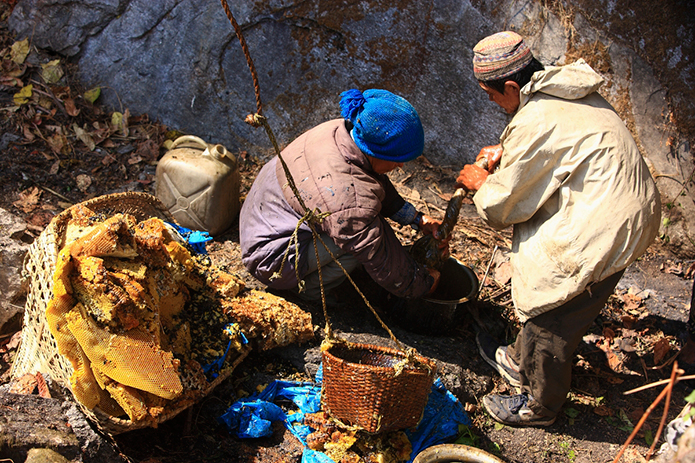
Once any stuck bees are summarily removed, the honey is filtered by being forced through a cloth, then stored in jerry cans. Image © Éric Tourneret / www.thehoneygatherers.com.
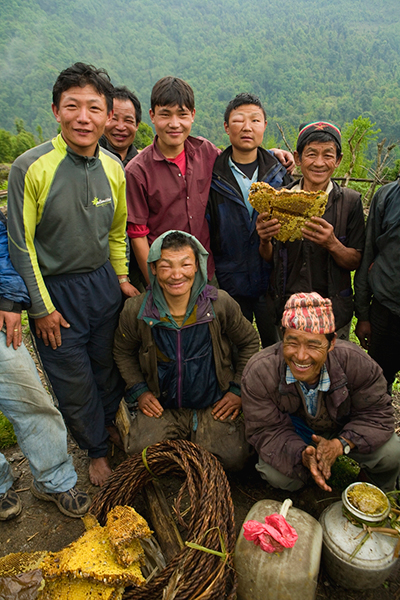
After the hunt, swollen hands, feet and faces. The team shows off their equipment and harvest of honey and wax. The first evening of the harvest, the men gather to spend the night in the hut of a herdsman, built on high-altitude pastures. Once again, the giant bee of the Himalayas put up a fearsome fight. Image © Éric Tourneret / www.thehoneygatherers.com.
New Zealand – Manuka – the treasure of the Maoris
The Manuka is the most prolific tree in its native New Zealand; it grows everywhere, across all the islands making up the nation, from the lowlands up to about 1500m in altitude. However, many Manuka trees have been lost to deforestation over the years, a process of clearing forest, historically Maori lands, for pasture, undertaken by the colonising Europeans.
At the start of the 21st Century Professor Peter Molan, from the department of honey research at the University of Waikato, discovered the exceptional antibacterial properties of Manuka honey. This lab-tested honey is graded according to its UMF (Unique Manuka Factor), which certifies its health-boosting properties, and now New Zealand exports 50 million euros worth of this elixir per year. Today, the Maoris, who own the land where this tree grows, have made apiculture their own, reclaiming their birthright, and creating much needed employment – from the management of the hives, to the processing and export of the honey to Japan, Korea and Europe. Whakaari International’s ‘Ora’ brand of Manuka Honey being one such example.
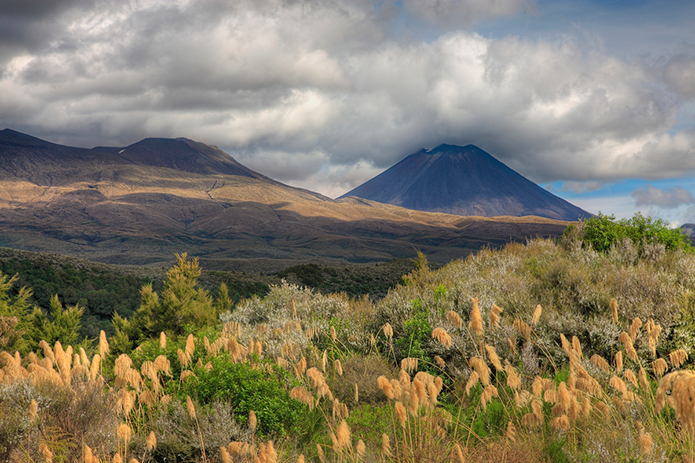
In the region of Lake Taupo and the Ruaperu (2797m) and Tongariro (1978m) volcanoes, the beekeepers bring their hives for the late flowering of the Manuka (due to the altitude and the temperature) in February. In Polynesian mythology, human beings, the elements and everything that makes up Nature descended from Father Sky and Mother Earth. That’s the reason why the ancient Maoris identified with all of nature. Image © Éric Tourneret / www.thehoneygatherers.com.

A young Maori sampling some Manuka honey. Peter Molan, from the University of Waikato (NZ) researched the therapeutic properties of Manuka honey. All Manuka honeys contain a specific enzyme, the UMF (unique manuka factor), which produces hydrogen peroxide, a recognized antiseptic and antibacterial of which the level varies enormously from one honey to another. The level contained in Manuka honey is approximately ten times higher than that found in other honeys. Image © Éric Tourneret / www.thehoneygatherers.com.
The Adamawa Plateau, Cameroon – A paradise for bees and disillusioned city Cameroonians
The abundance of flowering trees on the high, lush and moisture-rich savanna on the high plateaus of the Adamawa is a paradise for native Adansonii bees. It is also a land of plenty for a new breed of farmer. Young Cameroonians, disillusioned by the unemployment in the cities, have come out to farm the bush, where agriculture is still traditional, subsistence and chemical free. Part of their farming practice is beekeeping, entailing perilous, yet rewarding, climbing into the trees to harvest the honey; allowing them to sustain themselves, their families, and the sustainable farming methods.
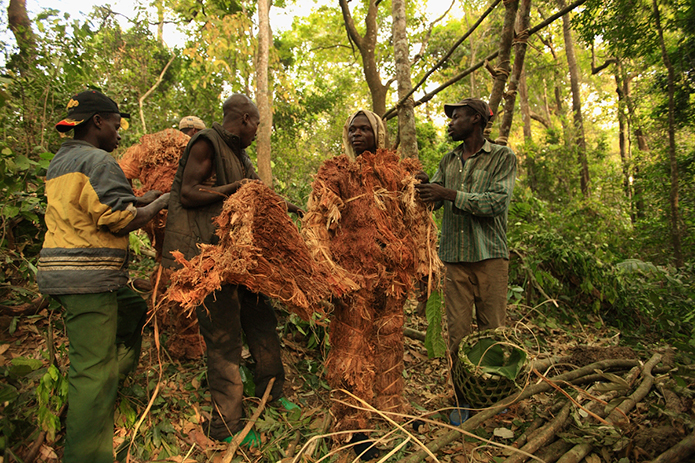
The men put on heavy suits made of wood fibre; indispensable for a daytime harvest. The sap from the tree that produces this wood gives off a substance that repels the bees. Image © Éric Tourneret / www.thehoneygatherers.com.
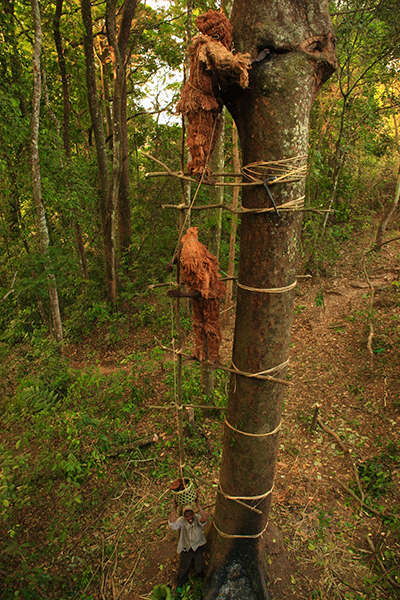
A colony of adansonii bees has been spotted in a tree. The local Gbaya people are sometimes guided by a larva-loving bird, the informer, which leads them right to the nests in exchange for part of the harvest. The nest, situated in the hollow of the tree more than fifteen metres off the ground, requires the honey gatherer to make a perilous climb without insurance, exposed to attacks by the bees. The basket woven of veins from the raffia leaf and now full of the precious nectar is lowered to the ground. Image © Éric Tourneret / www.thehoneygatherers.com.
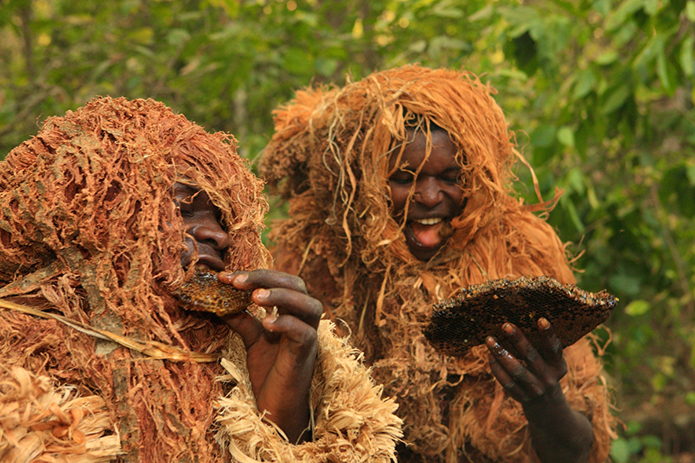
The reward following the harvest. This type of harvest, taking place during the day and without smoke, is practiced less and less. It comes from a time when, during wars, the fighters took refuge in the forest. Honey and water and some wild yam provided him who knew how to find them several weeks of subsistence. Image © Éric Tourneret / www.thehoneygatherers.com.
Rural France – monks, monoliths, donkeys, and dung
It is only relatively recently we have been able to understand the mystery of the bee and their hives – the threat of the sting has been extremely affective in keeping us humans at a distance. Domestication of the bees, beginning, we think in the Middle East, has progressed through human civilisation to more familiar apiculture such as that practised in France, compared to the exotically unfamiliar tree and delta hives we have just seen. The Frenchman Réaumur must be acknowledged for aiding this progression with his observations of a glass-cased hive in the 18th Century; derivations of which are still enjoyed today.
These days, although less exotic, beekeeping tradition still has centuries old resonance; monks practise apiculture in beautifully simply wooden hives; monolithic-looking chestnut trunk and slate hives (bruscs) can still be found in Cevennes; farmers in rural Provence use traditional transhumance transportation – donkeys; and resourceful use of local oak, straw and dung to make hives can still be found (just) in the Basque-lands.
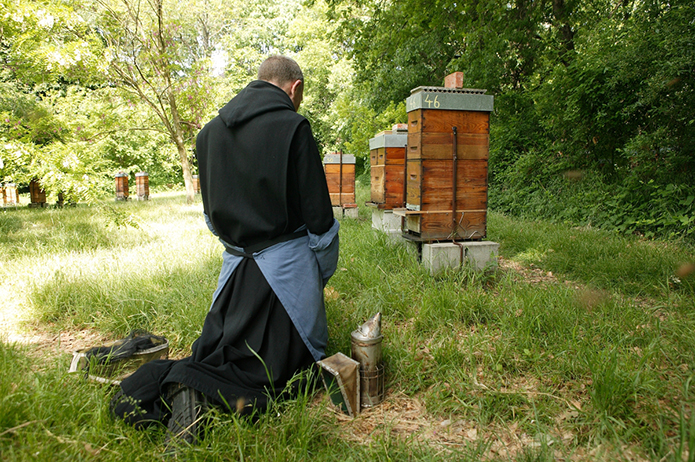
At the Triors Abbey (Abbaye Notre-Dame de Triors, Drome, France), Friar Claude keeps an apiary of forty hives to produce the abbey’s honey. For centuries, abbeys and monks were important honey and wax producers. Image © Éric Tourneret / www.thehoneygatherers.com.
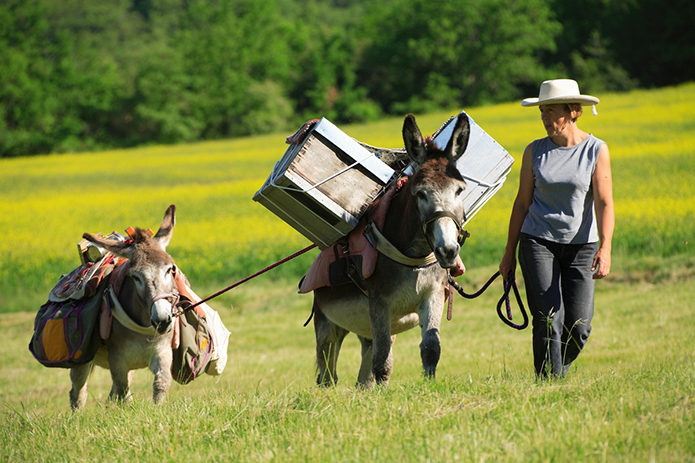
Donkeys used to be used for the transhumance. Pascaline, beekeeper and donkey herder in Bourdeaux, Drome, France, has used a few beehives to reconstruct a scene inspired by the history of Provence. Image © Éric Tourneret / www.thehoneygatherers.com.
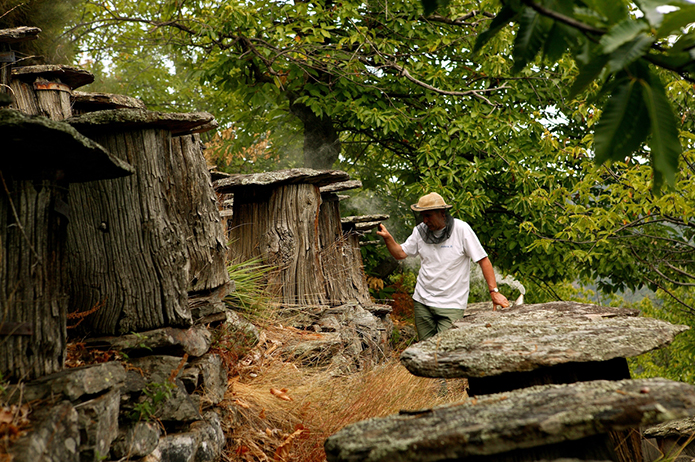
A Cevennes apiculturist with his smoker inspects a trunk apiary located at the heart of a chestnut grove. These ancient sedentary beehives called “bruscs”, are dug out in chestnut trees and covered in slate slabs. These type of hives was used until World War II. Image © Éric Tourneret / www.thehoneygatherers.com.
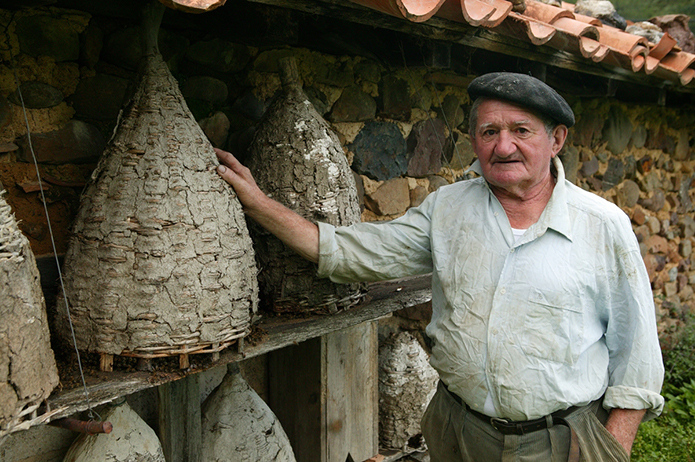
In the Basque Country, this farmer, who is nearing retirement, still owns a few straw hives. Image © Éric Tourneret / www.thehoneygatherers.com.
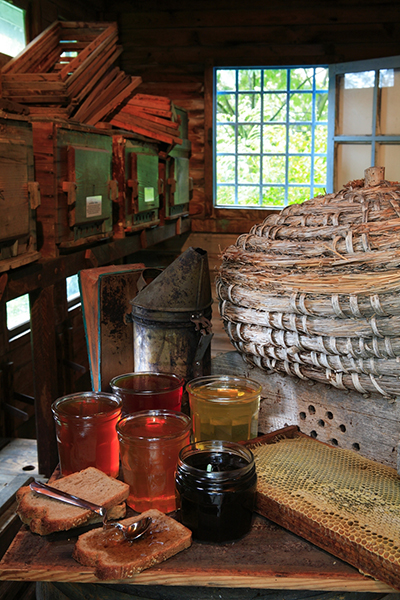
In Saint-Faust, near Pau: the ambience created by an old wooden apiary recovered from a religious institution, a smoker, a frame, and old-fashioned honey pots. Image © Éric Tourneret / www.thehoneygatherers.com.
Bohemian honey – Romania’s migrants beekeepers
Romania’s 2007 entry into the EU signified a period of modernisation within a country of great rural traditions. One iconic image of Romania is the Romany Gypsy Caravan, complete with brightly coloured painted panels and upholstery traversing country roads. This tradition can still be witnessed, in the form of migrant beekeepers, travelling around the forested mountains of the Maramures, Northern Romania. These beekeepers travel with their hives, coming together in camps farming and living in an extremely traditional way, eschewing the agricultural revolutions brought about by mechanisation and monoculture seen elsewhere in pretty much the whole of Europe.
The sight of wooden shingle-roofed houses, timber churches and picket fences are reminiscent of the ancestral farming culture that make up the man-made fabric of these traditional rural areas, symbolised by the ‘tree of life’ carvings seen on wooden porticos. Yet for how much longer can such a traditional environment support a growing population, with little or no industry to support subsequent generations? The pull of the modern world, the EU and all associated change endangers these traditions.
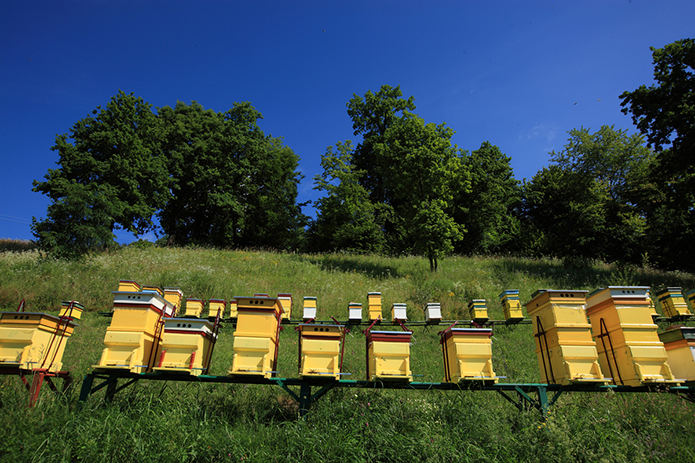
Beehives neatly lined up in the hillside in Romania. Image © Éric Tourneret / www.thehoneygatherers.com.
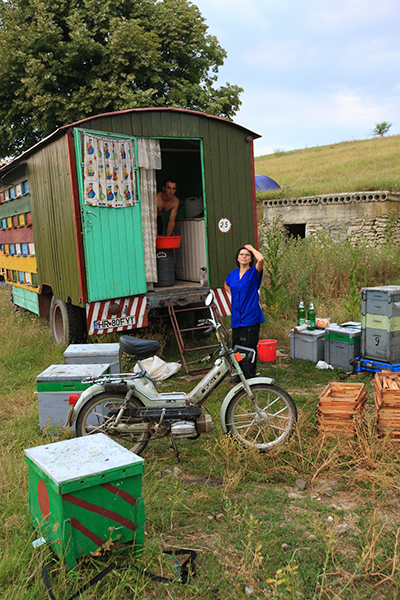
At the campsites, mutual aid is common; the beekeepers get together by affinity or because they come from the same region. The majority comes from Northern Romania. Image © Éric Tourneret / www.thehoneygatherers.com.
America’s Migrant Worker Bees – The Nomads of Mass Pollination with a catch
Migrant beekeepers can also be found in the US, yet not in quaintly painted gypsy caravans, upholding a form of simply subsistence agriculture, but thousands of Kenwood trucks – this is nomadic farming on an industrial scale. It is a strange sight, many men in white overalls, lifting, loading and transporting hives of 40 billion bees in 3,000 trucks, all bound for the almond groves of Central Valley, California, in February; not for honey harvesting, but for pollination of the delicate almond blossom.
Californian almonds are a 2 billion dollar, and growing, industry. The bees are big business; with a pollination window lasting about three weeks they can generate up to $175 per hive per week. The pollination industry, this new branch of apiculture, now represents at least half of some beekeeper’s revenues. However, there is a catch to this seemingly simple, big bucks phenomenon – this mass movement and concentration of colonies means bees are more exposed to the transmission of disease – this is proving catastrophic to American bee numbers – as Colony Collapse Disorder (CCD) is wiping out colonies at a frightening rate of a third per year.
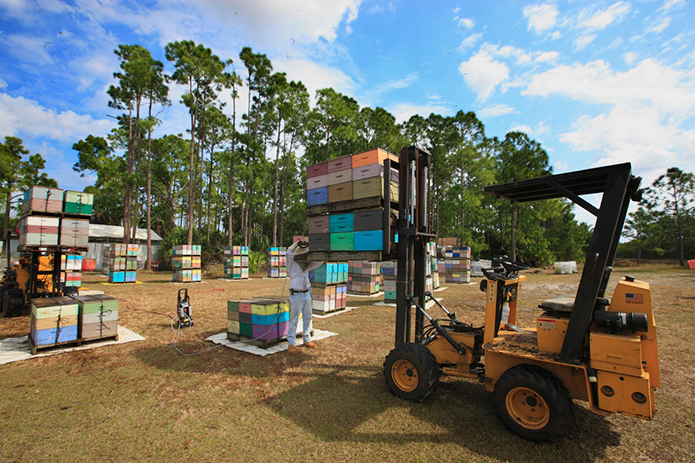
At Bob Harvey’s apiary in West Palm Beach, Florida: preparation of the hives and an inspection to detect the presences of ants on the hive’s pallets. Insecticide was sprayed on the ground fifteen days ago and the pallets cleaned with a high pressure water cleaner. Image © Éric Tourneret / www.thehoneygatherers.com.
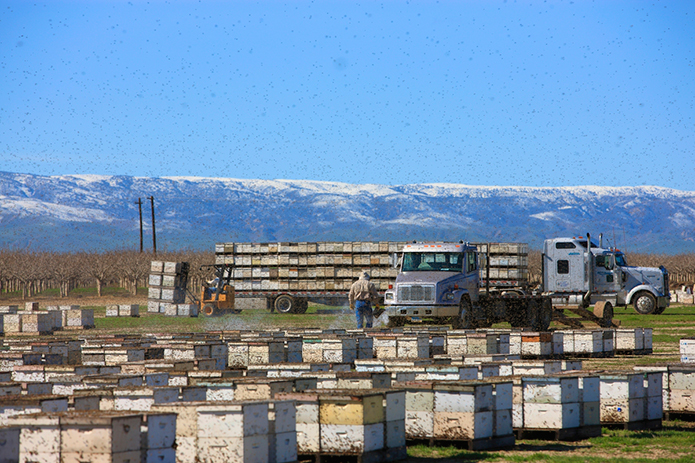
Three trucks arrived during the night. More than 1,200 hives to unload and inspect before taking them to the orchards. Image © Éric Tourneret / www.thehoneygatherers.com.
Rural Britain
A wonderful example of how a beekeeping family can sustain bee colonies, make a living out of the honey and beeswax, and inform us about the importance of apiculture, is the Chain Bridge Honey Farm, in the very north of England. A family business since the late 1940s, acquiring bees from retiring beekeepers, it has expanded over the years, with around 2000 hives over a 40 mile radius. It now has a third honey-house, to complement two others, kitted out resourcefully utilising machinery from local redundant shipyards, producing more than 80 tonnes of honey annually, supplying 350 shops. The 15 or so people employed are local and all contribute to the management of the hives, including construction and maintenance of the hives and machinery, in the extraction of honey and other by-products. A real success story for both man and bee!
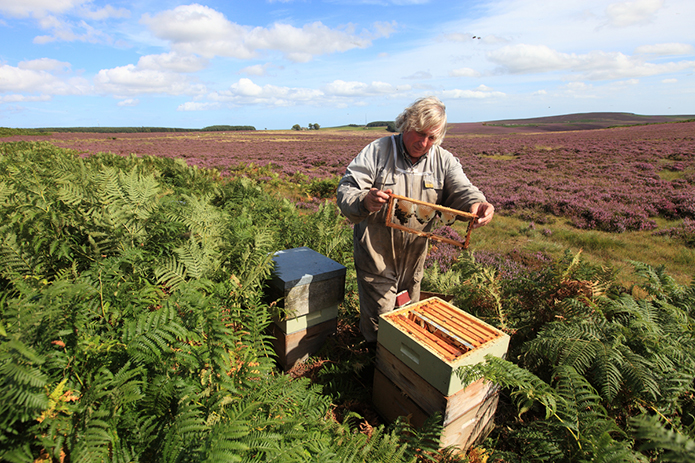
The Chain Bridge Honey Farm is a flourishing family business since 1948. Willie Robson in Northumberland has more than 1800 hives and produce heather honey. Image © Éric Tourneret / www.thehoneygatherers.com.
Urban Beekeeping – London, Paris and New York
Big cities may be the surprise saviours in the plight of the bee under threat from loss of habitat and chemical-induced starvation. With an increasingly monochrome mono-cultural countryside, devoid of patchwork diversity, and bathed in an invisible haze of agricultural chemicals, cities may unexpectedly offer a better balanced and purer environment for the bees. Environmentalists have been repeatedly stressing in (not so) recent years that a balance between mankind of nature must be restored. As the famous journalist and organic food guru Rosie Boycott stresses, “a declining bee population has potentially catastrophic consequences for the life of Man as we know it. With more and more people living in the cities, it is important to try to find out more about the decline of the bees and to see how we can reverse this trend.” It may be the tiny humble bee, reintroduced and flourishing within the city, man’s archetypal artificial creation, that is the first step on the long road to restoring this vital balance.
London
In London, the mayor, Boris Johnson, previously stressing the importance of the humble bee in food production and as “a reliable barometer for measuring the health of our natural environment” initiated a competition, funded by the government, to set up 2012 gardens (to mark the 2012 London Olympics year) and 50 apiaries, as well as beekeeping training courses. Londoners were also encouraged to grow melliferous plants (those that can be harvested by domesticated honey bees) and not just random flowers, fruit and vegetables, using the least chemical products possible, to encourage responsible apiculture and make London a bee friendly city.

The hives of Royal Festival Hall. Barnaby Shaw has been fascinated by bees since his childhood when his father owned bees who all died from varroa mite. Barnaby began beekeeping in 2004 a bit by accident when he recuperated a swarm while he was working on an urban farm in London. “You can find bees in the most extraordinary of places and often the swarms settle in the most improbable of spots. Recently, I was called to get a swarm of bees at the top of a plane tree next to South Bank Centre. I had to go in a crane. I was there in my beekeeping outfit, fifteen or so metres off the ground, with all the tourists and other spectators watching me from below! Image © Éric Tourneret / www.thehoneygatherers.com.
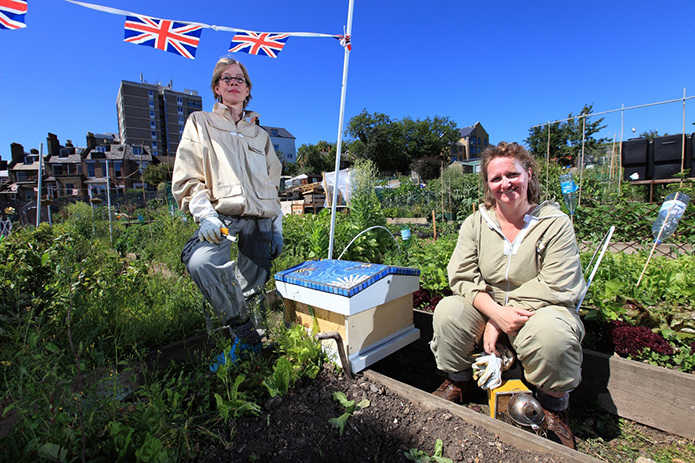
Sharon Bassey on the right and Liz Gill in the Stuart Road allotments where Sharon started a garden that became an apiary. Today, Sharon is leading a group of seven people through the apiary. Sharon works with children with learning difficulties and Liz repairs clocks. Image © Éric Tourneret / www.thehoneygatherers.com.
New York City
In New York City, in a similar time scale, 2008, the New York City Beekeeper’s Association was set up, forming a group of like-minded bee-minded people, established apiarists through to absolute beginners. Again, a highly unlikely environment, proving highly successful in the promotion, management and sustainability of these vital little insects.
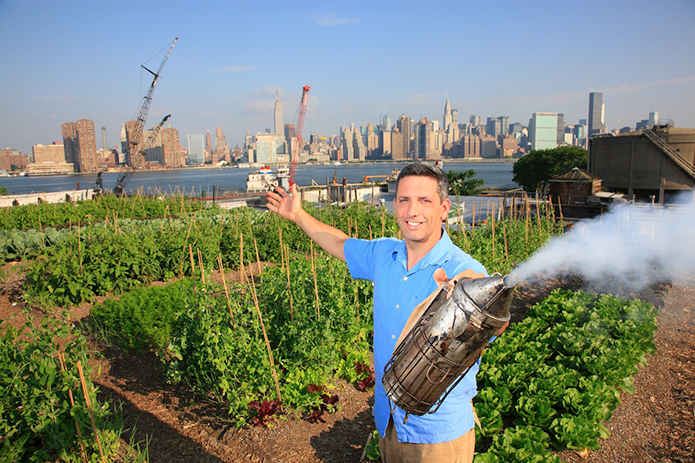
Andrew Coté, 38 years old, is the founder of the New York City Beekeepers’ Association, created in December 2008 and which is rapidly growing, bringing together experienced and beginner beekeepers and also all bee lovers. Here, at an apiary in Brooklyn. “Brooklyn abounds in lindens and acacias, the flora is diverse, but it’s the first year that we have a large number of hives in NYC”. Image © Éric Tourneret / www.thehoneygatherers.com.
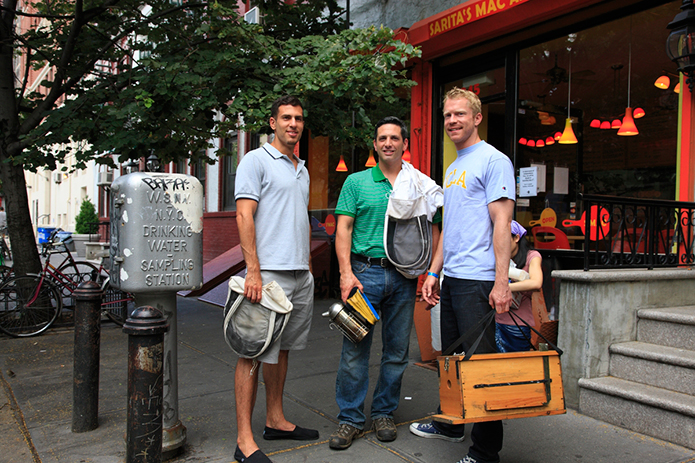
Portraits of young beekeepers with their materials in New York. Andrew Coté, beekeeper, Adam Johnson, a novice, and Troy Seidman, a curious friend. “Inspecting the hives is difficult in New York, for parking your car, carrying the material… And on top of that, urban beekeeping requires a more serious monitoring of the colonies because of swarming. I have 20 hives in NYC; everything goes all right because the members of the association help each other to monitor the hives. But a few days ago, there was a swarm right in the heart of Manhattan, with its train of police officers, safety zones…”. Image © Éric Tourneret / www.thehoneygatherers.com.
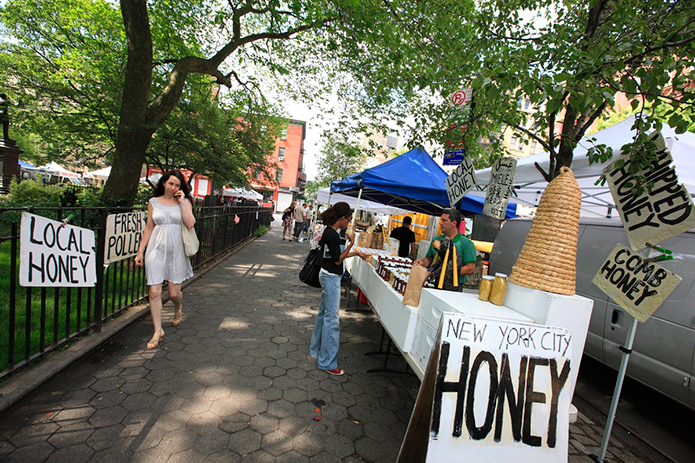
Andrew Coté sets up each week in the green and organic markets in the city of New York at Union Square and in Tompkins Square Park to sell his New York bees’ production and also the honey from his 220 hives in Connecticut. Image © Éric Tourneret / www.thehoneygatherers.com.
Paris
In Paris, there are more than 300 hives thriving on the roofs and gardens, as the city is reasonably pesticide-free and provides a variety of blossom. Like Londoners, the Parisians have also become keen apiarists; beekeeping classes subscribed to, and supplies purchased, in record numbers. The Parisian beekeepers may well be contributing to the salvation of the bees; as opposed to an average of 10 to 20 kilos for hives in the fields of rural areas, the city hives can produce up to 100 kilos of honey per year.
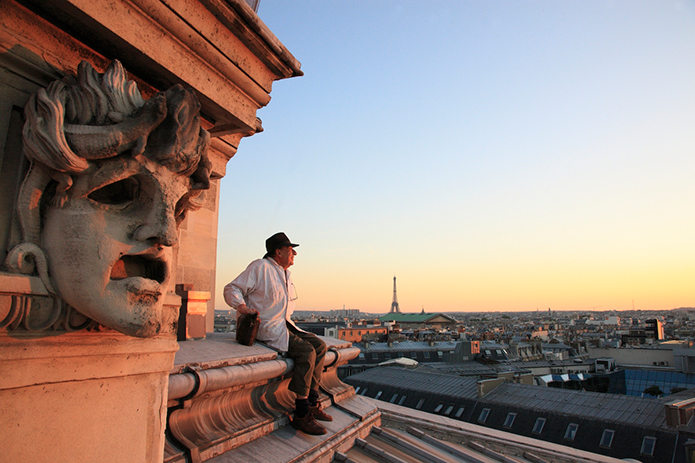
Jean Paucton, 76 years old, set up his hives twenty years ago on the roof of the Opera Garnier just by chance. A prop man at the opera, he took courses in beekeeping at the Société Centrale for apiculture in the Luxembourg gardens. Sharing his time between Paris and the Creuse, he didn’t know what to do with a hive given to him by a friend. It was the Opera fireman, who himself bred fish in the underground pond beneath the opera, who gave him the idea of setting the bees up on the roof of the Garnier. Image © Éric Tourneret / www.thehoneygatherers.com.


